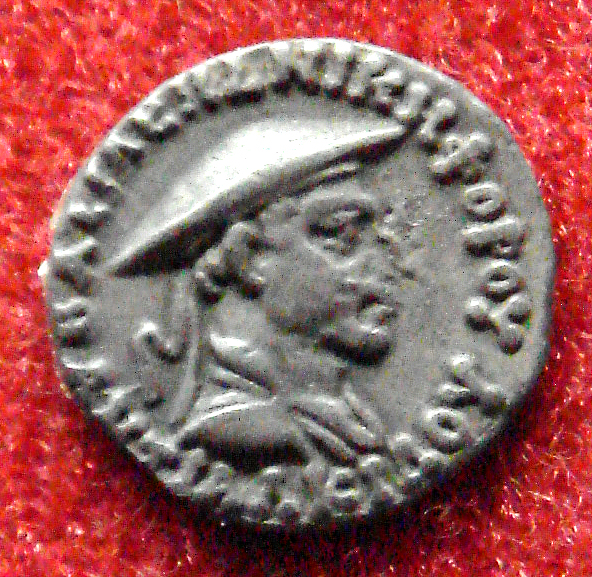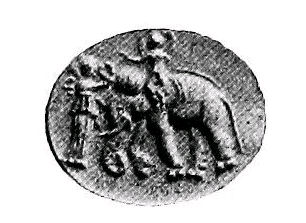Antialkidas on:
[Wikipedia]
[Google]
[Amazon]
 Antialcidas Nikephoros ( grc, Ἀντιαλκίδας ὁ Νικηφόρος;
Antialcidas Nikephoros ( grc, Ἀντιαλκίδας ὁ Νικηφόρος;
 Though there are few sources for the late Indo-Greek history, Antialcidas is known from an inscription left on a pillar (the Heliodorus pillar), which was erected by his ambassador Heliodorus at the court of the
Though there are few sources for the late Indo-Greek history, Antialcidas is known from an inscription left on a pillar (the Heliodorus pillar), which was erected by his ambassador Heliodorus at the court of the
Shane Wallace, 2016, p.222-223 A part of the inscription says: :"This Garuda-standard was made by order of the Bhagavata ... Heliodoros, the son of Dion, a man of Taxila, a Greek ambassador from King Antialkidas, to King Bhagabhadra, the son of the Princess from Benares, the saviour, while prospering in the fourteenth year of his reign."

 There is a bronze which features the obverse of Lysias and the reverse of Antialcidas. This was interpreted by Tarn and other earlier scholars as though the two kings might have forged some kind of alliance, but later, a bronze with the opposite arrangement was found.
Modern scholarship has however largely accepted that what was originally supposed to be a "joint issue" was in fact a
There is a bronze which features the obverse of Lysias and the reverse of Antialcidas. This was interpreted by Tarn and other earlier scholars as though the two kings might have forged some kind of alliance, but later, a bronze with the opposite arrangement was found.
Modern scholarship has however largely accepted that what was originally supposed to be a "joint issue" was in fact a
File:Antialkidas with Zeus giving wreath of victory to elephant.jpg, Antialkidas with Zeus directly giving wreath of victory to the elephant. With Greek legend ΒΑΣΙΛΕΩΣ ΝΙΚΗΦΟΡΟΥ ΑΝΤΙΑΛΚΙΔΟΥ "Of Victorious King Antialcidas"
Coins of Antialcidas
{{DEFAULTSORT:Antialcidas Indo-Greek kings 1st-century BC rulers in Asia 2nd-century BC rulers in Asia
 Antialcidas Nikephoros ( grc, Ἀντιαλκίδας ὁ Νικηφόρος;
Antialcidas Nikephoros ( grc, Ἀντιαλκίδας ὁ Νικηφόρος; epithet
An epithet (, ), also byname, is a descriptive term (word or phrase) known for accompanying or occurring in place of a name and having entered common usage. It has various shades of meaning when applied to seemingly real or fictitious people, di ...
means "the Victorious", Brahmi
Brahmi (; ; ISO 15919, ISO: ''Brāhmī'') is a writing system of ancient South Asia. "Until the late nineteenth century, the script of the Aśokan (non-Kharosthi) inscriptions and its immediate derivatives was referred to by various names such ...
: 𑀅𑀁𑀢𑀮𑀺𑀓𑀺𑀢𑀲 ''Aṃtalikitasa'', in the Heliodorus Pillar) was a king of the Indo-Greek Kingdom, who reigned from his capital at Taxila
Taxila or Takshashila (; sa, तक्षशिला; pi, ; , ; , ) is a city in Punjab, Pakistan. Located in the Taxila Tehsil of Rawalpindi District, it lies approximately northwest of the Islamabad–Rawalpindi metropolitan area and ...
. Bopearachchi
Osmund Bopearachchi (born 1949) is a Sri Lankan historian and numismatist who has specialized notably standardized the coinage of the Indo-Greek and Greco-Bactrian kingdoms. He is currently Emeritus Director of the CNRS at the École Normale Supé ...
has suggested that he ruled from ca. 115 to 95 BCE in the western parts of the Indo-Greek realms, whereas R. C. Senior places him around 130 to 120 BCE and also in eastern Punjab
Punjab (; Punjabi: پنجاب ; ਪੰਜਾਬ ; ; also romanised as ''Panjāb'' or ''Panj-Āb'') is a geopolitical, cultural, and historical region in South Asia, specifically in the northern part of the Indian subcontinent, comprising ...
(which seems better supported by coin findings). Senior does however believe that he ruled in tandem with King Lysias
Lysias Anicetus (Greek language, Greek: ; epithet means "the Invincible") was an Indo-Greek king.
Time of reign
According to numismatist Bopearachchi, Lysias was a close successor to Menander I and Zoilos I, and therefore may have ruled around 1 ...
.
Genealogy
Antialcidas may have been a relative of the Greco-Bactrian king Heliocles I, but ruled after the fall of the Greco-Bactrian kingdom. Several later kings may have been related to Antialcidas:Heliokles II
Heliocles II Dicaeus (Greek: ; epithet means "the just") is thought to have been one of the later Indo-Greek kings and a relative of the Bactrian king Heliocles I. Current scholarly consensus is that he ruled ca 95–80 BCE.
Heliocles II seem ...
, Amyntas, Diomedes
Diomedes (Jones, Daniel; Roach, Peter, James Hartman and Jane Setter, eds. ''Cambridge English Pronouncing Dictionary''. 17th edition. Cambridge UP, 2006.) or Diomede (; grc-gre, Διομήδης, Diomēdēs, "god-like cunning" or "advised by ...
and Hermaeus
Hermaeus Soter or Hermaios Soter ( grc, Ἑρμαῖος ὁ Σωτήρ; epithet means "the Saviour") was a Western Indo-Greek king of the Eucratid Dynasty, who ruled the territory of Paropamisade in the Hindu-Kush region, with his capital in Alex ...
all struck coins with similar features.
The Heliodorus inscription
 Though there are few sources for the late Indo-Greek history, Antialcidas is known from an inscription left on a pillar (the Heliodorus pillar), which was erected by his ambassador Heliodorus at the court of the
Though there are few sources for the late Indo-Greek history, Antialcidas is known from an inscription left on a pillar (the Heliodorus pillar), which was erected by his ambassador Heliodorus at the court of the Shunga
is a type of Japanese erotic art typically executed as a kind of ukiyo-e, often in woodblock print format. While rare, there are also extant erotic painted handscrolls which predate ukiyo-e. Translated literally, the Japanese word ''shunga'' ...
king Bhagabhadra at Vidisha, near Sanchi. It states that he was a devotee of Vishnu, the Hindu god.Greek Culture in Afghanistan and India: Old Evidence and New DiscoveriesShane Wallace, 2016, p.222-223 A part of the inscription says: :"This Garuda-standard was made by order of the Bhagavata ... Heliodoros, the son of Dion, a man of Taxila, a Greek ambassador from King Antialkidas, to King Bhagabhadra, the son of the Princess from Benares, the saviour, while prospering in the fourteenth year of his reign."
Coins
Otherwise, Antialcidas is also known through his plentiful coins. He issued a number of bilingual Indian silver types: diademed, wearing a helmet with bull's horns or a flat kausia. He also appears throwing a spear. According to some interpretations (Grousset), the baby elephant may symbolize the BuddhaSiddhartha Gautama
Siddhartha Gautama, most commonly referred to as the Buddha, was a wandering ascetic and religious teacher who lived in South Asia during the 6th or 5th century BCE and founded Buddhism.
According to Buddhist tradition, he was born in Lu ...
, who took the shape of a small elephant to enter the womb of his mother Queen Maya
Queen Māyā of Shakya ( sa, मायादेवी, pi, Māyādevī) was the birth mother of Gautama Buddha, the sage on whose teachings Buddhism was founded. She was sister of Mahāpajāpatī Gotamī, the first Buddhist nun ordained by the ...
, a scene often depicted in Greco-Buddhist art
The Greco-Buddhist art or Gandhara art of the north Indian subcontinent is the artistic manifestation of Greco-Buddhism, a cultural syncretism between Ancient Greek art and Buddhism. It had mainly evolved in the ancient region of Gandhara.
The s ...
. In that case the coin scene would represent a victory of Buddhism. According to other interpretations the elephant was the symbol of the city of Taxila
Taxila or Takshashila (; sa, तक्षशिला; pi, ; , ; , ) is a city in Punjab, Pakistan. Located in the Taxila Tehsil of Rawalpindi District, it lies approximately northwest of the Islamabad–Rawalpindi metropolitan area and ...
.
"Mule coins" (overstrikes)

 There is a bronze which features the obverse of Lysias and the reverse of Antialcidas. This was interpreted by Tarn and other earlier scholars as though the two kings might have forged some kind of alliance, but later, a bronze with the opposite arrangement was found.
Modern scholarship has however largely accepted that what was originally supposed to be a "joint issue" was in fact a
There is a bronze which features the obverse of Lysias and the reverse of Antialcidas. This was interpreted by Tarn and other earlier scholars as though the two kings might have forged some kind of alliance, but later, a bronze with the opposite arrangement was found.
Modern scholarship has however largely accepted that what was originally supposed to be a "joint issue" was in fact a mule
The mule is a domestic equine hybrid between a donkey and a horse. It is the offspring of a male donkey (a jack) and a female horse (a mare). The horse and the donkey are different species, with different numbers of chromosomes; of the two pos ...
; in other words, a mistake occurred in the process of overstriking the original coin, and it was accidentally issued with both king's standards.
References
Sources
* ''The Shape of Ancient Thought. Comparative studies in Greek and Indian Philosophies'' by Thomas McEvilley (Allworth Press and the School of Visual Arts, 2002) * ''Buddhism in Central Asia'' by B. N. Puri (Motilal Banarsidass, January 1, 2000) * ''The Greeks in Bactria and India'', W. W. Tarn, Cambridge University Press. * ''The Indo-Greeks'', A. K. Narain, B.R Publications * ''The Decline of the Indo-Greeks'', R. C. Senior & D. MacDonald, the Hellenistic Numismatic SocietyExternal links
Coins of Antialcidas
{{DEFAULTSORT:Antialcidas Indo-Greek kings 1st-century BC rulers in Asia 2nd-century BC rulers in Asia